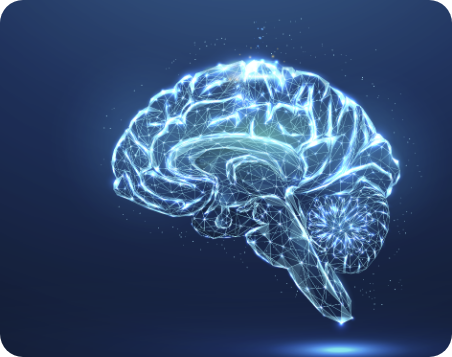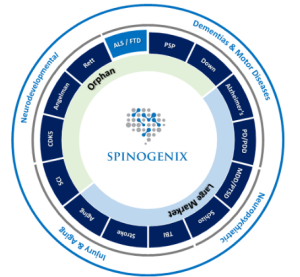SCIENCE
Treatments for diseases such as Alzheimer’s disease, amyotrophic lateral sclerosis (ALS),
schizophrenia, and Fragile X syndrome (FXS) leave a critical gap in effective and patient-friendly
solutions. At Spinogenix, we want to do more than slow disease progression. Patients deserve
game-changing treatments that offer renewed hope. Our unique approach has the potential to be used alone as a “monotherapy” or as a restorative component to combination therapies that
include treatments targeting specific disease processes.
Spinogenix is pioneering a new way to treat conditions characterized by the loss or dysfunction
of the fundamental building blocks in the brain called synapses, which are the connections
between neurons through which signals flow and allow us to think, plan, remember, and control motor functions. Our platform of novel small molecule drugs has the remarkable property of being able to restore synapses with the potential to reverse declines in cognitive and motor function that could benefit people with ALS, Alzheimer’s Disease, schizophrenia, FXS, movement disorders, and other diseases.

Synapses are connections between neurons through which signals flow from one neuron to another. They are a fundamental and indispensable physical basis for neural communication, enabling cognition, movement, perception, memory, and other faculties of mind. Deterioration
of synapses is an early and progressive feature of a broad spectrum of neurodegenerative, neuropsychiatric, and other diseases collectively known as the “synaptopathies”. For any therapy to have a chance at reversing the symptoms of these diseases in patients, it must promote the restoration of synapses.
 The synaptopathies comprise a large and diverse set of conditions spanning neurodegenerative diseases, neuropsychiatric conditions, and neurodevelopmental disorders, as well as injury and aging. In many of these conditions, including Alzheimer’s disease and other dementias, amyotrophic lateral sclerosis, and schizophrenia, degenerative processes lead to a reduction in synapse number. In conditions such as Fragile X syndrome and other neurodevelopmental disorders, synaptic function may be more specifically compromised rather than a complete loss of the synaptic connection itself.
The synaptopathies comprise a large and diverse set of conditions spanning neurodegenerative diseases, neuropsychiatric conditions, and neurodevelopmental disorders, as well as injury and aging. In many of these conditions, including Alzheimer’s disease and other dementias, amyotrophic lateral sclerosis, and schizophrenia, degenerative processes lead to a reduction in synapse number. In conditions such as Fragile X syndrome and other neurodevelopmental disorders, synaptic function may be more specifically compromised rather than a complete loss of the synaptic connection itself.
There are no approved therapies that regenerate synapses or correct specific defects in synaptic function to restore cognitive, motor, and other functions in any of these diseases. Spinogenix is a leader in this space with its first-in-class synaptic restoration small molecule platform.
Amyotrophic Lateral Sclerosis (ALS)
ALS, also called Lou Gehrig’s disease, is a neurodegenerative disease that results in the progressive loss of motor neurons that control voluntary muscles. ALS is an orphan disease that affects as many as 30,000 people in the United States, with approximately 5,000 new cases diagnosed each year. ALS is the most common form of motor neuron disease, characterized by progressive paralysis and, almost invariably, death by respiratory failure within 2-5 years of diagnosis. Around half of people with ALS develop at least mild difficulties with thinking and behavior, and about 15% develop frontotemporal dementia. There is no known cure for ALS.
Alzheimer’s Disease
Alzheimer’s Disease is the most common cause of dementia, accounting for ~60-70% of dementia cases worldwide. Alzheimer’s Disease affects nerve cells in the brain involved in learning, memory, and other cognitive abilities, causing a progressive loss of these functions that greatly impact a person’s quality of life. Loss of synapses occurs very early in Alzheimer’s and is a major driver of progressive impairments in cognition and memory. Currently, there is no cure for Alzheimer’s Disease, and medications that are approved for use have only a modest effect on symptoms and the rate of disease progression.
Fragile X Syndrome
FXS is the leading inherited form of intellectual disability and a known cause of autism that results from the silencing of the Fmr1 gene. FXS is an orphan disease affecting approximately 1 in 4-5000 men and 1 in 6-8000 women globally. In addition to intellectual disability, FXS patients endure a wide range of disabling symptoms, including severe anxiety, social aversion, hyperactivity and attention deficit, sensory hypersensitivity, aggression, developmental seizures, and others. Providing care for individuals with FXS often becomes a full-time commitment for at least one parent and imposes significant financial strain, with direct family healthcare costs totaling $4.1 billion annually in the United States alone. Despite the considerable impact of FXS, there are currently no FDA-approved drugs available for those with the condition.
Schizophrenia
Schizophrenia is one of the most debilitating and prevalent psychiatric conditions, affecting around 24 million people worldwide. Symptoms of schizophrenia include “positive symptoms” such as hallucinations and delusions, “negative symptoms” such as anhedonia and social withdrawal, and “cognitive symptoms” such as working memory deficits. Positive symptoms can be treated with antipsychotics, but available treatments often leave many people’s symptoms inadequately addressed. Negative and cognitive symptoms are not well addressed by current medications. Synapse loss is a major feature of schizophrenia that begins during brain development and may contribute to each symptom domain. Available treatments for schizophrenia do not reverse synapse loss.
Many of the new therapies being developed for neurodegenerative diseases such as ALS and Alzheimer’s disease are large macromolecules called “biologics”. These biologics have difficulty penetrating the central nervous system (CNS) and require IV infusion or intrathecal injections.
Such therapies, which include antibodies that bind to toxic proteins or oligonucleotides that suppress the expression of a disease-related gene product, are often difficult to administer and costly to produce at scale. At Spinogenix, we are focused on developing small molecule drugs
designed to pass through the blood-brain barrier and penetrate the CNS. Our drugs are designed to be taken by mouth as a once-a-day pill, which has multiple benefits: ease of drug administration, improved patient compliance, and significant reduction in cost. Altogether, our therapeutics may provide a simple, cost-effective, yet powerful approach to treating synaptopathies.
Our lead candidate for neurodegenerative and neuropsychiatric disorders, SPG302, is part of our platform of drugs that have a unique set of properties termed TAGS™, which stands for Transient Activators of Glutamatergic Synaptogenesis. Our proprietary TAGS™ technology enables SPGs to trigger the formation of new synapses that use the amino acid glutamate as a neurotransmitter. Such synapses are the most common type of “excitatory” synapses (meaning that they stimulate the receiving neuron), and they are preferentially lost in many neurodegenerative diseases. SPGs work by regenerating dendritic spines, the specialized small protrusions of neural membrane that comprise the postsynaptic element at ~90% of glutamatergic synapses:
The synaptogenic effect of SPG302 as seen by labeling of dendritic spines. Images are from apical dendrites in the CA1 field of hippocampus in drug naïve (left) and drug treated (right) animals.
The regenerative activity of SPGs is remarkably well suited to treat synaptopathies. Some of the key features of activity are as follows:
- Rapid Acting– Induce the formation of new, functional dendritic spine synapses within 4 hours or less in vitro, while synaptic and behavioral benefits are evident in vivo within weeks during daily treatment.
- Sufficient Transient Exposure– Synaptic regeneration and behavioral benefits in cognitive and motor symptoms in animal models (ALS, Alzheimer’s, spinal cord injury, traumatic brain injury) are achieved with daily dosing of SPGs that have a relatively short half-life.
- Self-perpetuating and Self-limiting– SPGs activate a process that carries forward on its own to generate physiologically relevant numbers and shapes of dendritic spine synapses. Treatment with higher doses than necessary, or for longer periods, does not alter this activity profile.
- Durable Effects– New synapses induced by SPGs can last weeks or more after cessation of drug treatment.
FXS is the leading inherited form of intellectual disability and a known cause of autism that results from the silencing of the Fmr1 gene. Silencing of this gene leads to large and complex changes in mRNA and protein expression that results in abnormalities in synaptic function. Some of these abnormalities have been shown to be a result of a reduction in the amount and activity of large-conductance, calcium-activated potassium (“BK”) channels. Many core symptoms of FXS have been linked to deficient activity of BK channels.
SPG601 is a novel small molecule BK channel activator that works by binding to BK channels and increasing their activation to correct specific synaptic dysfunctions, addressing core symptoms of FXS.
Deficits in BK channel expression and activity have been linked to other conditions as well. Accordingly, pharmacological upregulation of BK channel activity has been proposed as a viable therapeutic strategy in several neurodegenerative (e.g., Alzheimer’s disease, multiple sclerosis), vascular (e.g., cerebral hypoperfusion/vascular dementia), organ-specific (e.g., overactive bladder) and sensory disorders (e.g., tinnitus and neuropathic pain).

